With more midseason drop-ins than usual, 1977 component lines are marked by some remarkable individual models.
by Robert Long and Harold A. Rodgers
IT IS TRADITIONAL for high fidelity manufacturers to show off in June what the boys in the back room have been dreaming up all winter. This way, production can begin in the summer for fall delivery and stocks can be built up for the most intensive selling season-which, by no coincidence, centers around the winter solstice, when nights are longest and the Great Outdoors least inviting. Major introductions of goods for mass consumption, from TV programs to automobiles, also occur in the fall, but post-solstice seasoning often is added: new pro grams or models, sometimes with a special glitter intended to reflect well on their meat-and-potatoes neighbors.
There is a midseason trade show for components---the Winter Consumer Electronics Show but it never has had the importance of its June counterpart. Among the welter of digital wrist watches and TV games and CB transceivers and calculators and car radios, high fidelity has seemed a little lost.
At this year's Winter CES--despite gossip that had given it advance billing as a bust and perhaps the last such display--the high fidelity exhibits were, if anything, livelier than usual. Not that all equipment manufacturers were represented; we base our comments here on all of the new products that came to our notice during the course of January and early February.
We saw a good deal of emphasis placed on convenience features: FM signal meters that will show multipath, automatic high-blend switching (in the presence of low signal strengths), reversing cassette decks, touch tuning (in which the tuned frequency is locked on as soon as the tuning knob is released), and many more. All share the same in tent-to do electronically or electromechanically some chore that the user formerly had to perform manually.
----

On the cover: The largest unit is the Sansui QXR-9001 quadriphonic receiver. Above it is the Bozak Model 909 preamp; at the lower right, the Polk Formula IV low-mass tone arm.
----
One related trend seems all to the good: the inclusion of some sort of block schematic right on the equipment. It has been commonplace for some time in professional equipment (like the Crown electronic crossover-see HF test reports, October 1975) and recently turned up in Technics and Nakamichi components. The schematic saves fishing out the owner's manual each time you have a question about the relationship between the controls or the input and output jacks. Last summer Hitachi took this idea further by outfitting a cassette deck with a front-panel block schematic that lights up to show signal routing for whatever positions the appropriate switches happen to be in. A Philips preamp adopts a similar approach this year.
We perceive, at some companies, an easing of the insistence on pushbuttons in front-panel de sign and a return to levers or rotary switches whose settings can be seen at a glance. Pushbuttons, we believe, leave a good deal to be desired in terms of human engineering (particularly when both they and the surrounding faceplate are black), and the alternative of using lighting indicators to tell you what is switched in and out just drives up costs. So the trend away from pushbuttons, if trend it be, looks good to us.
On the strictly cosmetic front, while the black faceplates with which so many companies regaled us last summer and fall are still there, new products appear to be under little constraint to adhere to this trend. Many exhibit the cool, silvery styling that has been associated with Yamaha's receiver line.
Electronics If the big cry in receivers over the last few years has been that their performance equals that of separates, the cry this year is that the super-receivers are the equivalent of a supertuner/superamp combination. In particular, there appears to be a watt age race going on. The Marantz Model 2385, at 22 3/4 dBW (185 watts) per channel, seems to have the power-number prize at the moment, though only by a tiny margin. (While 180 watts-available in the Rotel RX-1603 receiver, whose amp section really can be mounted as a separate-translates to 22 1/2 dBW, working to the nearest 1/4-dB, the spread between the two actually is only about 1/2 dB!) Power isn't all that makes a super-receiver, how ever, and Marantz tends to place even more emphasis on the technical accomplishments of its tuner section than on those of its amplifier.
Toshiba-which also talks of its receivers rivaling separates-has gone back to the term tuner/ amplifier and has styled its receivers so that they have the appearance of a shallow tuner sitting atop a shallow integrated amp. The tuning dial, incidentally, is tilted for easier visibility when it is below eye level. Perhaps this is something of a trend; Pioneer, Nikko, Hitachi, Sanyo, and others also have angled dials. Some lines (like the new Wintec by Monarch series, distributed by SDI) put the dial flush with the faceplate to minimize visibility problems. Others, like Sherwood and San sui, keep recessed dials tall.
Sansui uses a light-spot "pointer" that moves both horizontally and vertically over a grid calibrated for every channel on the dial. In tuning to 92.7 MHz, for example, you turn the knob until the light spot is in the grid area for 92-93 MHz, adjust it until it coincides with the horizontal calibration for 0.7 MHz, and then do the final fine-tuning from the meters. (We should note that the light-beam dials are on Sansui's quadriphonic receivers-the only new models of this genre we have seen for some time-and have not yet been included in its stereo models.) A simpler, though far less comprehensive, tuning aid from Pioneer is a series of movable indexing pointers just below the dial so that a few favorite stations can be "marked." There are some circuitry innovations in tuners this year, though nothing as glamorous as the micro-computer digital job that Sherwood unveiled last summer and is expecting to have on sale this spring. Perhaps the most important new feature will prove to he pilot canceling. Both Pioneer and Yamaha are using this technique-involving an out-of-phase pilot, rather than a filter--to null out the 19 kHz in stereo reception because it does not impinge on the audio itself. Response curves should look flatter at the top end, though we suspect high-frequency distortion measurements may not look as good since unwanted harmonics that are suppressed by filtering will be allowed to pass with pilot canceling. (The Yamaha receiver in this month's test reports section seems to confirm this surmise.) Optonica (a new component line from Sharp) has adopted "air check calibration," apparently similar to the recording-level-check feature introduced by Pioneer last year that helps in presetting levels for recording from FM. (Since full-modulation output is the same for all stations received above marginal signal strengths, a single reference tone can be used.) Switchable IF bandwidth-al lowing a tradeoff between maximum selectivity and minimum distortion-seems to be on the in crease in FM tuners. And Philips has, we hope, started a ball rolling by designing one of the few real high fidelity AM sections to go with the FM in its AH-673-44 tuner.
If receiver amplifier sections are embroiled in a power race, separate amplifiers apparently have moved away from their similar noisy rivalry of a few years ago and now are immersed in what might be called a class struggle. Class AB remains the rule for solid-state amps, but Sony has introduced its Class D (switching) amplifier, using vertical FETs, while Hitachi continues to add models incorporating the Class G configuration. (For a description of Class G, see the HF test reports section, April 1977.) Incidentally, Class G-which originally was known as Class E and now is employed in products that Hitachi calls Series E should not be confused with System-E, a term Paragon Audio uses for its all-triode tubed preamp, the first model in what it plans as a full line of separates.
Meanwhile, one circuit feature associated with vacuum tubes is making something of a comeback in transistor amps: the output transformer. Both Sansui and McIntosh have reintroduced it, largely in the interests of optimizing power transfer to the speakers-not among the strong points of the direct coupling that has become commonplace of late.
There was some skepticism when, a few years ago, Harman-Kardon introduced its models with a separate power supply for each channel. The purpose-ultimate clarity and stability in the stereo image through minimum possible interaction be tween channels-appears to be shaping up as a major concern among other companies, notably Technics, Kenwood, and Mitsubishi. The latter's new electronics line includes one nice touch we had not seen before: a metering subassembly that can be added to the front of a power amp, making
----------
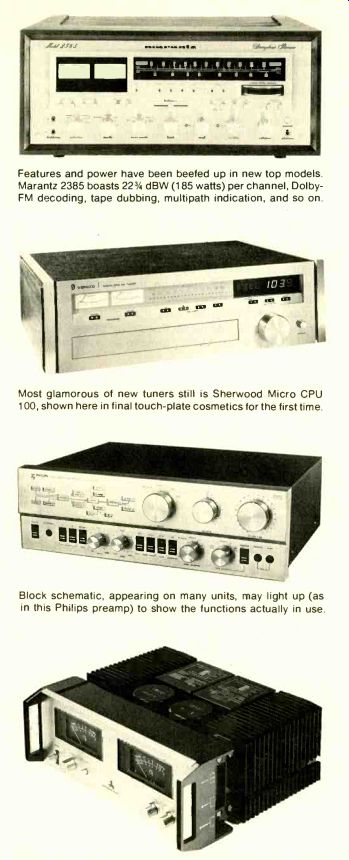
Features and power have been beefed up in new top models. Marantz 2385 boasts 223A dBW (185 watts) per channel, Dolby-FM decoding, tape dubbing, multipath indication, and so on.
Most glamorous of new tuners still is Sherwood Micro CPU 100, shown here in final touch-plate cosmetics for the first time.
Block schematic, appearing on many units, may light up (as in this Philips preamp) to show the functions actually in use.
An interesting innovation is metering / control front panel that can be added to Mitsubishi power amps afterward, if you buy the unmetered model and later change your mind.
it easy to retrofit power metering and the associated functions (level controls, speaker switching) that come on the same panel.
Phono inputs seem to be claiming a good deal of attention in integrated amps and preamps. The roster of available models appropriate for low-output moving-coil pickups, with input-impedance switching and with phono gain controls (to match nonstandard pickup outputs to the other in put levels handled by the preamp), continues to grow. Hegeman Labs has introduced an electronic device called the Input Probe, designed to improve the match between the pickup (or a tape deck) and the preamp input and thus improve detail, dynamic range, and stereo over that of the same components without the Probe.
Among new preamps from relatively unfamiliar companies are the Ace 3000 and 3100 (the former also is available as a kit), the Audionics BT-2, and the Bauman Research M-200, which is designed around a J-FET operational amp module. Nakamichi has revived the preamp-plus-tuner format in its Model 630, which features a huge circular tuning dial and LEDs instead of meters as tuning aids. It also has introduced the 610 integrated amp in this series, plus the new 400 series, including the Model 410 preamp. All follow the black faceplate trend.
Equalizers remain important, though there are indications that the flood of new models has slowed. Cerwin-Vega has added the DB-10, which boosts response (by either 5 or 10 dB) in the 32-Hz range while reducing response sharply below 20 Hz and leaving the range above 60 Hz virtually unaffected. And SAE recently began delivery of its parametric equalizer. But most companies seem to be thinking primarily in terms of the graphic equalizer. ;VC, for example, has included a ten-band SEA in its top (JP-S7) control preamp. An all-new separate graphic equalizer comes from Klark Teknik in England, a division of Lamb Labs.
Among Bozak's newest electronics is the Model 900 Celeste time-delay unit, whose imminence has been rumored for some time. It uses the bucket-brigade technique to create its "ambience"--and, not incidentally, undersells previous consumer time-delay devices by some $100.
In noise-reduction equipment, probably the biggest news recently was the announcement of SAE's Model 5000 impulse-noise suppressor, designed to reduce the pops and clicks that most noise-reduction techniques are powerless to combat. [See "News and Views" in this issue.] Among the more conventional models, Burwen Research has updated its Dynamic Noise Filter (both in circuitry and in styling) with the DNF-1201A.
Two other units that attracted our attention this year are not what one might normally class as high fidelity products. One is the Rhoades Model TE 300 TV-audio tuner, which is designed to deliver to your stereo system the best signal quality broad casters will allow (certainly the limiting factor on fidelity here). Though other companies have talked about putting out such a product for the consumer audio market, only Rhoades seems to have accepted the challenge. The other product is, in a sense, Rhoades in reverse: It takes audio and feeds it to your TV picture as an abstract color display. It's called the Atari Video Music, and it offers (by contrast to the typical "color organ" devices of a few years ago) a fascinating range of options.
Speakers and Headphones
Certainly the most striking thrust of loudspeaker design at the moment is the attempt to eliminate phase anomalies from the propagated sound. This thrust probably is most closely associated in most readers' minds with the Dahlquist designs in which the drivers are positioned so that, in effect, the voice coils all fall in the same plane, and with the B&O designs in which the crossover networks (including the use of "filler drivers" where necessary) are calculated for minimum net phase shift.
But there have been other essentially minimum-phase designs (the Walsh drivers from Ohm, for example), and a number of companies--from B&W in England to Technics in Japan--have recently de voted themselves to the problems involved.
Not the least of these problems is the question of the audibility of phase distortion. While inquiry continues and the mass of data grows, one can easily find all shades of engineering opinion from the classic, "It doesn't matter, particularly when you consider the phase distortion to which all program sources have been subjected before they reach the speaker," to "This is the biggest breakthrough in speaker design in years." Take your pick. And take a listen for yourself.
------
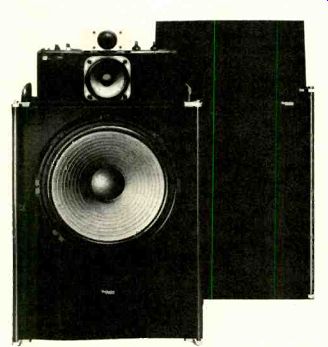
Many of the new speakers, particularly at higher prices, strive for maximum phase linearity: this is Technics' SB-7000A.
-------
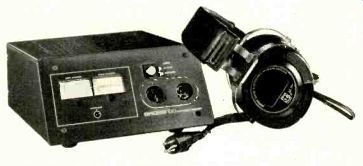
Koss ESP-10 is one of new headphone models that profit from current
approach to subjective performance perception.
--------
We sense some me-too-ism among manufacturers of minimum-phase speakers. While most of these companies appear to be making an honest at tempt to solve what they honestly believe to be a real problem, we suspect that during the next year or two a few designs will adopt (at least cosmetically) the set-back drivers of minimum-phase designs for reasons that have more to do with fad sales than with engineering.
But this sort of design still represents only a small fraction of the loudspeaker market-which continues to collect new models and new companies at an astounding rate. For years we have asked ourselves how all of these newcomers can continue in business, dividing the loudspeaker market into ever smaller slices. Yet most of the new--as well as old--companies survive; that is, their products fill a need of one sort or another.
The headphone market is quite different. New brands generally offer inexpensive models and seldom have much staying power because a business based on price rather than engineering can be demolished at one stroke of a price list. Among the engineering-oriented headphone-only companies, Koss and Superex over the last decade have put a good deal of emphasis on the development of couplers by means of which reliable measurements of headphone performance could be made, anomalies of behavior discovered, and designs improved through engineering knowledge as opposed to cut-and-try guesswork.
Having done all this work, which has had immense impact on design, these companies now seem to be taking a new look at the psychoacoustics of headphone listening with a view to further refining the perceived sound image. Models like the Koss ESP-10 electrostatic and Auditor and the Superex TRL-77 are the current result.
----------
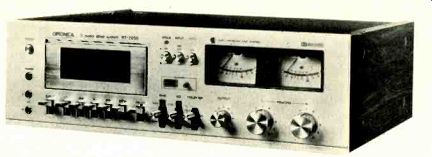
One of many current cassette decks with ferrichrome switching. Optonica's RT-2050 also offers a unique program-finding system to sense "spaces" between music.
----------
Tape Recording
The Elcaset is being eyed, perhaps a bit suspiciously, by manufacturers of tape and decks alike.
In response to questions about when-and whether-products in this format might appear, we have consistently been given answers amounting to: "It's too early to tell." The question, even in the minds of those executives who already have committed their companies to Elcaset production, is what sort of customer will prove receptive. The shaping of products and marketing strategies hangs on that question, and until there are some answers the Elcaset probably will bob about, at times precariously, as a trial balloon.
Among companies not yet involved with the Elcaset, the emphasis on ever-improving cassette performance and convenience makes a strong bid to undercut whatever acceptance it might attain in the consumer market. Akai, for example, has introduced a bidirectional deck, the GXC-730D. And Optonica has an indexing system called APLD (Automatic Program Locate Device) that senses the absence of signal and uses the information for random-access playback of the cassette's contents.
The system-incorporated initially into the avail able RT-3535 deck but also shown (in a more sophisticated form) in a feature-refulgent prototype super-deck-directly counters the "cue track" of the Elcaset, which is its proprietary mechanism for random access (though initial Elcaset decks do not make use of it). Nakamichi, meanwhile, is directing attention to increased headroom in cassette gear-a process already begun in the Model 600--and introduced the 1000-II and 700-II (up grades of the previous Models 1000 and 700, but without resorting to the 600's IM Suppressor) to prove its point.
Many of the new cassette decks offer bias/ equalization switching for ferrichrome tapes, but this approach is by no means accepted across the board. Some deck manufacturers, in fact, claim that they cannot optimize the eq. circuits for both ferrichrome and ferric tapes without driving costs up. Their solutions: either omit ferrichrome or get by with the nearest match that the ferric-oriented curves will yield. In addition, some models (the Dokorder MK-630, for example) incorporate continuously variable bias controls, allowing a degree of "fine tuning" that is denied by discrete-position switches.
A growing number of "chrome" settings seem to be engineered, rather, for the chrome-compatible ferric tapes like TDK SA and Maxell UDXL-II.
(The difference in deck adjustment between these tapes and chromes is minor-only a few dB in sensitivity.) One reason for the change may be the assumption that Japanese tape manufacturers will continue to drop chromium-dioxide formulations, at least in part because of concern over chrome pollution in that country. (It seems to us that, if chrome pollution is a key factor, it will inhibit manufacturers of ferri-chromes as well, but apparently different recorder companies lay their plans on the basis of different information.) The 3M Company now has a tape comparable to UDXL-II and SA--it's called Scotch Master II--and another ferrichrome (in addition to Classic) called Master Open-reel equipment continues to keep a vanishingly low profile in moderate-priced stereo consumer wares, while remaining preemptively popular with those who need quasi-professional capabilities. The assault of the eight-track cartridge on home high fidelity is a thing of the past; even in low-priced equipment-AC, battery-port able, automotive, whatever-it is staggering before the relentless growth in the popularity of the cassette in all but youth-oriented products.
-------------------
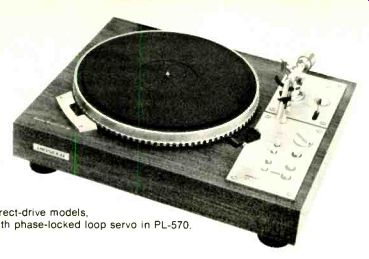
----- Quartz control, in many direct-drive models, is combined by Pioneer with phase-locked loop servo in PL-570.
Record-Playing Equipment
The biggest single threat to quality music reproduction in the home, we are told by equipment manufacturers and readers on so many occasions, is poor quality control in the manufacture of discs themselves. Paradoxically, there is a great deal of really sophisticated design going into record-playing equipment these days.
Moving-coil cartridges, sometimes at astronomical prices, continue to attract much interest among listeners devoted to the best possible disc play back, as the availability of inputs designed for these pickups demonstrates. Not all require special high-gain inputs (or pre-preamps, otherwise known as head amps), however. Two high-output moving-coil lines mentioned in our new-products roundup (September 1976)--Satin and Onlife, the latter originally announced here by BGW--have found new U.S. distributors since then. The Satin line, now distributed by Osawa & Company, has several new models; the Onlife models are available as Dynavector from Audioanalyst.
Win Laboratories, after being held back by un foreseen problems, is in production with its pickup-a strain-gauge design related to the Euphonics cartridge of some years back (and whose patents Win has acquired). Another nonstandard pickup (assuming as standard the moving-magnet or similar magnetic pickups such as those produced by Pickering, Shure, ADC, Empire, and Stanton) is the electret design from Micro-Acoustics. Its latest, the 282-e, is specifically said to "track warped records 25% better than any competitive brand cartridge and [be] immune to the effects of cable [capacitance]." These claims hit squarely at two centers of concern: The capacitance of interconnect cables and preamp input stages has, to some extent, been lowered and standardized by CD-4, to which these values are critical; and record warps seem as much in evidence as ever. Both problems have, in a sense, been aggravated by the ever greater stylus compliance achieved over the last few years-in it self a contribution to greater fidelity but requiring better matching in associated equipment if response characteristics from infrasonic warp re production through audible sound to supersonic CD-4 carrier recovery are not to get out of hand.
Arm/cartridge resonance, therefore, is a major concern, particularly in tracking what one reader recently called the "frilled" discs coming out of American pressing plants. The attempt to control resonance (and response to warps) produced the plug-in arm (as opposed to a plug-in shell), a major feature of the new Thorens turntable line. Dynavector this year will be introducing its radically different arm, whose moving mass is concentrated at the very end and decoupled from the rest of the arm by a pivot just inboard of the cartridge mounting. Several ultra-lightweight arms (like the new Infinity Black Widow and the British-made Polk Formula IV) also seek to keep resonance above the warp range with high-compliance pickups by reducing moving mass.
In turntables themselves, quartz-controlled servo drive is showing up from a number of manufacturers, including Pioneer, JVC, Sansui, and Technics. While direct drive remains a glamour feature, some companies continue to maintain that they can do better, particularly in terms of infra sonic rumble, which-though too low in frequency to be heard in and of itself-can inter-modulate with audible frequencies and even overload preamp input stages if RIAA boost continues be low 20 Hz. Thorens, for example, says that any rumble spec that can be achieved by direct drive always can be improved upon by adding a belt to decouple the drive from the platter. A new company, Gillespie-Thorn Systems, is readying for market the Oasis turntable, using a fluid suspension system for both drive and platter "bearings." Netronics, a company that specializes in devices to prevent acoustic feedback, has added a 78-rpm speed lo its dual-suspension turntable.
Automatic features abound on top single-play models, though no new models are as automated as the ADC Accutrac introduced last year. The new Mitsubishi DP-EC1, however, includes automatic disc-diameter sensing and, coupled to it, automatic speed setting (45 for seven-inch discs, 33 for others), plus arm setdown, liftoff, return, and (if you want it) repeat. In record changers-which, of course, have by no means been eclipsed by the recent renewed interest in single-play models there is a new/old name: Collaro. Audiophiles with long memories will recall it from the 1950s; new models will issue from Collaro in Fort Wayne, Indiana. And, as we reported in our last is sue, the Elac turntables--long sold as Miracords by Benjamin--are back with new designs and distribution. Welcome.
(High Fidelity, May. 1977)
Also see: